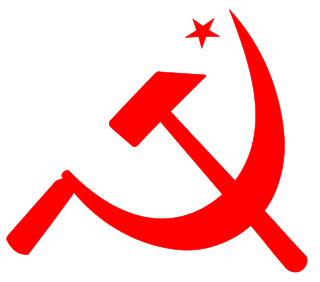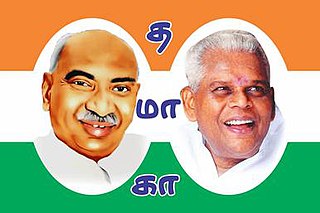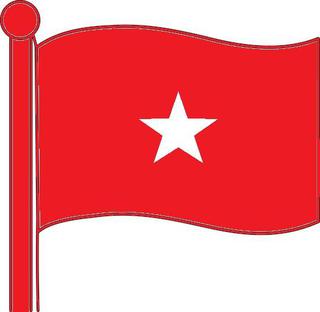Related Research Articles

The Communist Party of India (Marxist) (abbreviated as CPI(M)) is a communist political party in India. It is the largest communist party in India in terms of membership and electoral seats, and one of the national parties of India. The party was founded through a splitting from the Communist Party of India in 1964 and it quickly became the dominant fraction.

The Communist Party of India (CPI) is the oldest communist party in India. The CPI was founded in modern-day Kanpur on 26 December 1925. Currently, it has two members in Lok Sabha and two members in Rajya Sabha. In addition, it has 22 MLAs across four states and one MLC in Bihar. It has the current ECI status of a state party in Tamil Nadu, Kerala and Manipur.
The Indian People's Front (IPF) was a mass front organisation founded in Delhi between 24–26 April 1982. It was conceptualised by Vinod Mishra and it was operated as the open mass front of the CPIML Liberation between 1982–1994. The front primarily worked for the social and economic upliftment of Adivasis, Dalits and impoverished sections of society and mobilised them through the means of unions, rallies and conventions.

The Tamil Maanila Congress (Moopanar) (transl. Tamil State Congress (Moopanar); abbr.TMC(M)) is an Indian regional political party in the state of Tamil Nadu. It was founded by the former member of parliament of the Republic of India G. K. Moopanar on 29 March 1996 as a breakaway faction from the Tamil Nadu Congress Committee.

Jagjivan Ram, known popularly as Babuji, was an Indian independence activist and politician from Bihar. He was instrumental in the foundation of the All India Depressed Classes League, an organisation dedicated to attaining equality for untouchables, in 1935 and was elected to Bihar Legislative Assembly in 1937, after which he organised the rural labour movement.
Devaraj Devaraj Urs was an Indian politician who served two terms as the first Chief Minister of Karnataka, a state in southern India. He is also the longest serving Chief Minister of Karnataka in terms of days of tenure in office. He entered politics in 1952 and was an MLA for 10 years. When the Indian National Congress split in 1969 as Samstha and Indira Congress, he stood with Indira Gandhi. He became the Chief Minister of Karnataka for the first time from 20 March 1972 to 31 December 1977 and later for the second time from 17 March 1978 to 8 June 1980.
Communism in India has existed as a social or political ideology as well as a political movement since at least as early as the 1920s. In its early years, communist ideology was harshly suppressed through legal prohibitions and criminal prosecutions. Eventually, communist parties became ensconced in national party politics, sprouting several political offshoots.

The Bolshevik Party of India is an Indian political party in India. The party was founded in 1939. The party had a certain role in the trade union movement in West Bengal and was briefly represented in the state government in 1969. In later years the party has played a negligible role in Indian politics.

Nagapattinam is a Lok Sabha constituency in Tamil Nadu. Its Tamil Nadu Parliamentary Constituency number is 29 of 39. The seat is reserved for scheduled castes. The constituency is noted for being an historically communist stronghold, having elected Communist Party of India parliamentary representative seven times.

The first legislative assembly Election to the Madras state based on universal adult suffrage was held in 27 March 1952. This was the first election held in Madras state after the Indian Independence. This election was officially known as the 1951 Madras State Election, even though through delays, actual voting didn't take place until early 1952.
Baddam Yella Reddy was an Indian communist politician from Telangana. He was one of the prominent leaders in the Telangana armed struggle against the Nizam regime.
U. C. Raman is an Indian politician from Kerala. As of 2011 he was the state president of the Indian Union Dalit League, the Scheduled Caste wing of the Indian Union Muslim League.

The 1952 Coorg Legislative Assembly election was held to constitute the Coorg Legislative Assembly, electing members of legislature for 18 constituencies of the erstwhile Indian State of Coorg. It took place on 27 March 1952 and a total of 87,947 people voted 24 out of 60 candidates to power. This was the only election to the assembly before the State was merged into Mysore as per the States Reorganisation Act in 1956.
The Lal Communist Party Hind Union was a political party in Punjab, India. The party was led by Teja Singh Swatantra. It led militant agrarian struggles in the PEPSU regions. The Lal Communist Party merged back into the Communist Party of India in 1952.
The Patiala and East Punjab States Union Legislative Assembly was the unicameral state-level legislative body of the Patiala and East Punjab States Union in India. Two elections to the assembly were held; one in 1951 and the second one in 1954. The assembly had 60 seats. The assembly used to meet at the Durbar (Court) of Qila Mubarak, the royal fort at Patiala.

Elections to the Legislative Assembly of the Indian state of Hyderabad were held and Sri Burgula Rama Krishna Rao took oath as First Chief Minister of Hyderabad State on 6 March 1952. 564 candidates competed for the 175 seats in the Assembly. There were 33 two-member constituencies and 109 constituencies single-member constituencies.
The Jammu Praja Parishad was a political party active in the Jammu Division of the Indian-administered Jammu and Kashmir. It was founded in November 1947 by the Rashtriya Swayamsevak Sangh activist Balraj Madhok, and served as the main opposition party in the state. It maintained close ties with Bharatiya Jana Sangh during its lifetime and merged with the latter in 1963. Its main activity was to campaign for the close integration of Jammu and Kashmir with India and oppose the special status granted to the state under the Article 370 of the Indian constitution. After its merger with the Bharatiya Jana Sangh, the precursor of the present day Bharatiya Janata Party, the party gradually rose in stature. As an integral part of the Bharatiya Janata Party, it was a partner in the ruling coalition led by the People's Democratic Party.

Legislative Assembly elections were held in the Indian state of West Bengal in 1991. The election took place simultaneously with the 1991 Indian general election. The term of the assembly elected in 1987 lasted until February 1992, but the West Bengal government asked the Election Commission of India to arrange the election at an earlier date.
Hari Krishna Vyas was an Indian politician.
Sant Singh Yusuf was an Indian trade unionist and politician.
References
- ↑ Communist Party of India. Documents of the Twelfth Congress of the Communist Party of India, Adhikari Nagar, Varanasi, 22 to 28 March 1982 . New Delhi: Communist Party of India, 1982. p. 34
- ↑ Sarkar, Subodh Chandra. Indian Parliament and State Legislatures, Being the Supplement to Hindustan Year Book, 1952 . Calcutta: M.C. Sarkar, 1952. p. 79
- 1 2 White, Bridget. Kolar Gold Fields: Down Memory Lane; Paeans to Lost Glory!! Milton Keynes: AuthorHouse, 2010. p. 46
- 1 2 3 4 The Hindu. Titans who built the Left edifice in State
- ↑ The Hindu. Veteran trade union leader dead
- ↑ United States. Directory of Labor Organizations, Asia and Australasia . [Washington]: For sale by the Supt. of Docs., U.S. Govt. Print. Off, 1963. p. U-14
- ↑ Economic and Political Weekly , Vol. 33. Sameeksha Trust, 1998. p. 1472
- ↑ Election Commission of India. STATISTICAL REPORT ON GENERAL ELECTION, 1951 TO THE LEGISLATIVE ASSEMBLY OF MYSORE
- ↑ Chatterji, Rakhahari. Unions, Politics, and the State: A Study of Indian Labour Politics . New Delhi: South Asian Publishers, 1980. p. 47